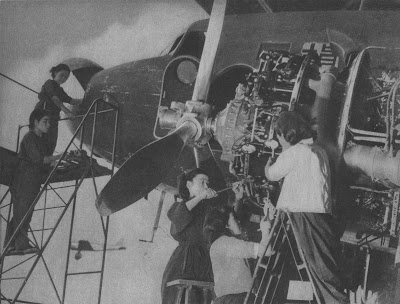Kawanishi (modern name ShinMaywa) was a company with a long tradition in seaplanes and flying boats. One of the most impressive was the H6K "Mavis". The first planes that left the production lines in 1938-1939 were in Natural Metal Finish like the plane in the photo below from a vintage magazine.
Once they started serving in the South Pacific front and following orders from the IJNAF regarding camouflage, "Mavis" flying boats became green-top, gray-bottom like the example below from a war news still.
Below is an artwork example.
And some beautiful artwork by Koike Shigeo of a civilian "Mavis" operated by Dai Nippon Koku K.K.
After the end of the war a couple "Mavis" were found in Yokohama as shown in the NARA photo below.
According to the surrender regulations the Japanese planes were to be painted white overall and carry green crosses. In the case of a huge flying boat like the "Mavis" it is only natural that this would have been a time-consuming process demanding large quantities of white paint. The results were naturally not beautiful. The "Mavis" in the foreground has half the fuselage and the tail painted white while the rest is left in its original paint. The plane in front of it is in even worse condition with only parts of the fuselage and the top surfaces of the wing painted haphazardly in white. The original caption mentions: "General view showing four Japanese Navy Seaplanes and ramp to the ocean at the Dainippon Arways, Yokohama, Japan. 14 September 1945."
I think that the "Mavis" in the foreground is also in the photo below offering a clear top view.
Note that the crosses are applied on top of the wing hinomaru. Were they green outlined in white over the red hinomaru or was it just the white outline over the red of the hinomaru contrary to the regulations?
Another rather interesting "Mavis" found after the end of the war is the one below.
The source of the photo is
this and according to the caption:
"
Mechanics of 3219 Servicing Commando, Royal Air Force (RAF), check the engines of a Japanese Kawanishi H6K 'Mavis' flying boat at Sourabaya (Soerabaja), Java, in preparation for an air test flight. Of interest are the markings added by Indonesian nationalists and the fact that an additional band of blue has been added to the fuselage marking by the Dutch."
Note that the
hinomaru on the fuselage and the wing are erased. Instead it has a Dutch flag on the fuselage and an Indonesian red/white marking under the wing. Note that it also used to have surrender crosses on the fuselage and under the wing (outlined in red); the one on the fuselage seems to have been also erased.
So what could the overall color be? Some mention that it was "silver" even though it would have an extremely rare exception since all Navy planes flying in the South Pacific were camouflaged by necessity. Others suggest that the whole paint of the plane was removed. But that would mean a very long and tedious process for no apparent reason.
The same "Mavis" later received British roundels and ATAIU SEA markings on the fuselage sides and was transported to Seletar base in Singapore as can be seen in the e-bay photo below.
Personally I think that either the plane in the photo is in overall white or more possibly RAF crew members repainted it in overall British "gray".






















































